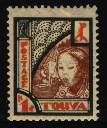These stamps were popular with stamp collectors. They showed pictures of this remote place, had interesting shapes, and were all postally necessary... after all they had run out of stamps in the country.
There are plenty of varieties to look for in this set, no matter what your sophistication. The most obvious variation is in Mirr 15...note the shape of the "1" in the below two stamps and you'll see what I mean. This variation is cataloged in all the significant stamp catalogs.
For the more addicted stamp collector, there are perforation varieties to hunt in this set. As I recall, the perforator for the triangular stamps left the margin imperforate, so the printers ran the sides through a line perforator. (Un)fortunately they didn't pay much attention to matching the perforation gauge of the rest of the sheet. There are five perf varieties of the 18k, three perf varieties of the 28k, and for some reason the 40 and 50k rectangular stamps also come in three perf combinations.
For the more philatelically nuts, there are also plate varieties to hunt for. Except for the article I wrote for the Tuvan Collector's Society newsletter, I have only found one article on plate varieties, and that is from 1955. [Scott, put that stuff up here].
Because of the popularity of these stamps, the low five values of the series were reprinted for sale to stamp dealers (actually, they were made for inclusion in stamp packets). The gum on these reprints is smooth.

Dealers: if you have large quantities of Mirr 15-19 send me a note. I'm sure there are more plate varieties waiting to be found.